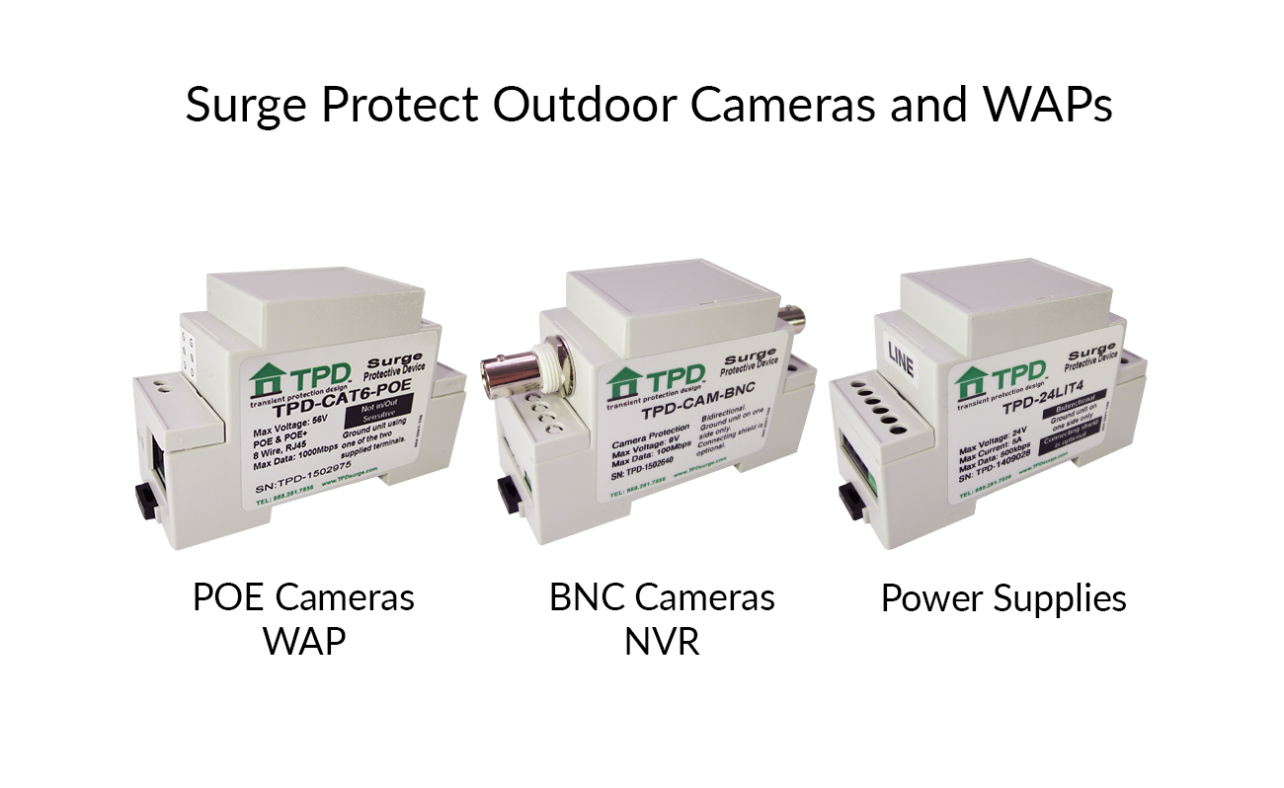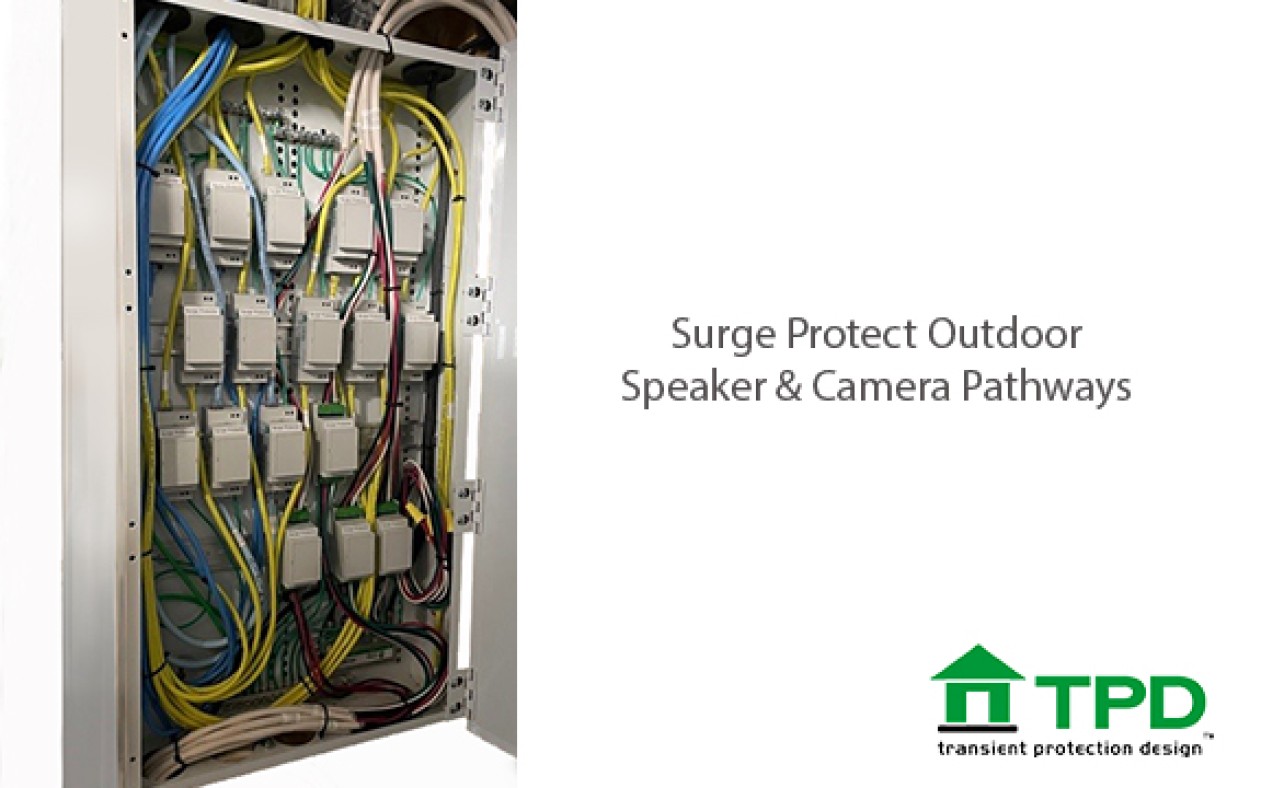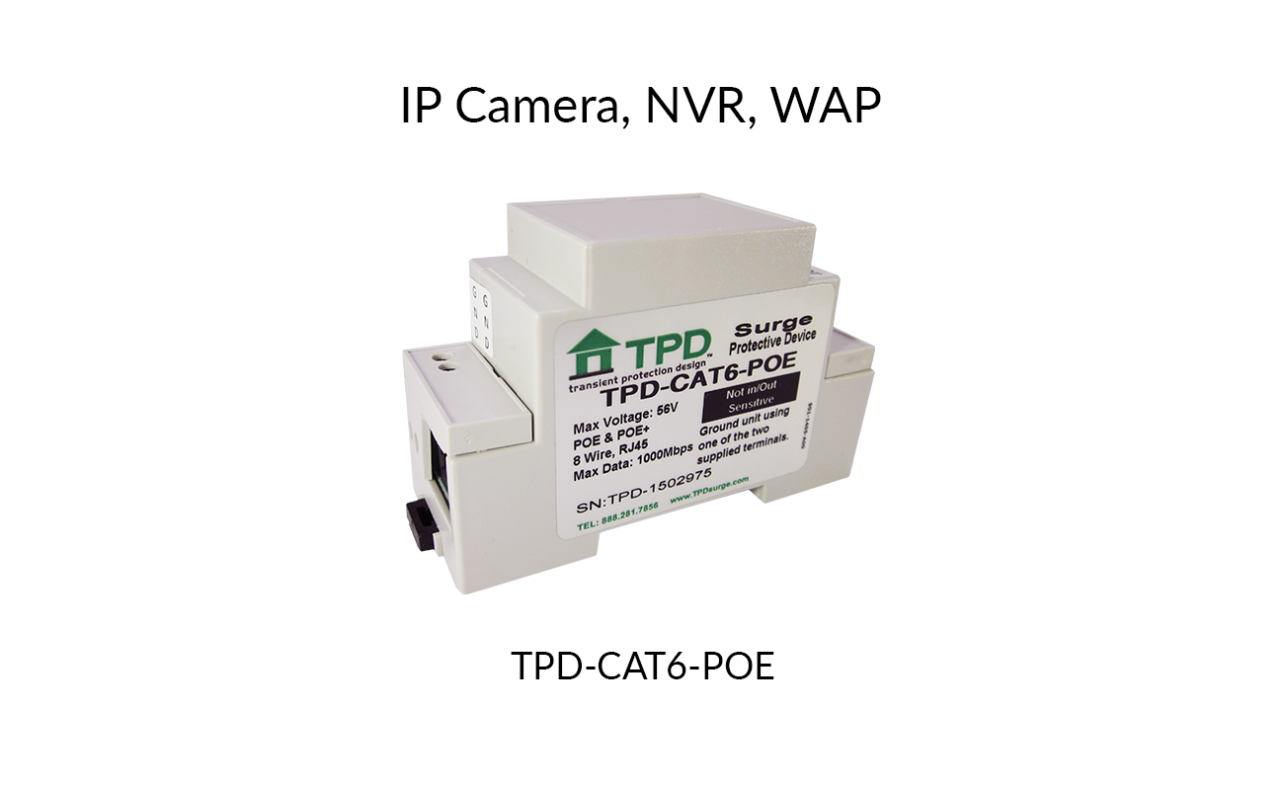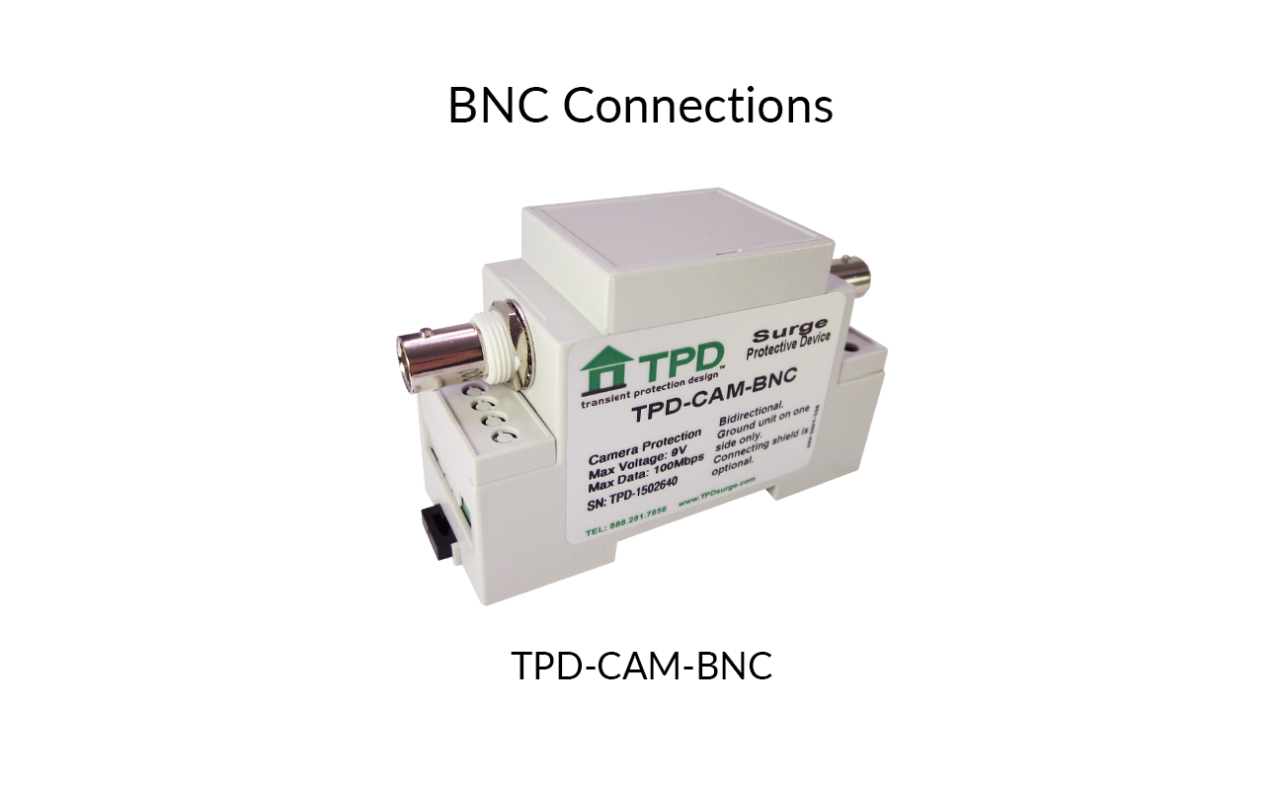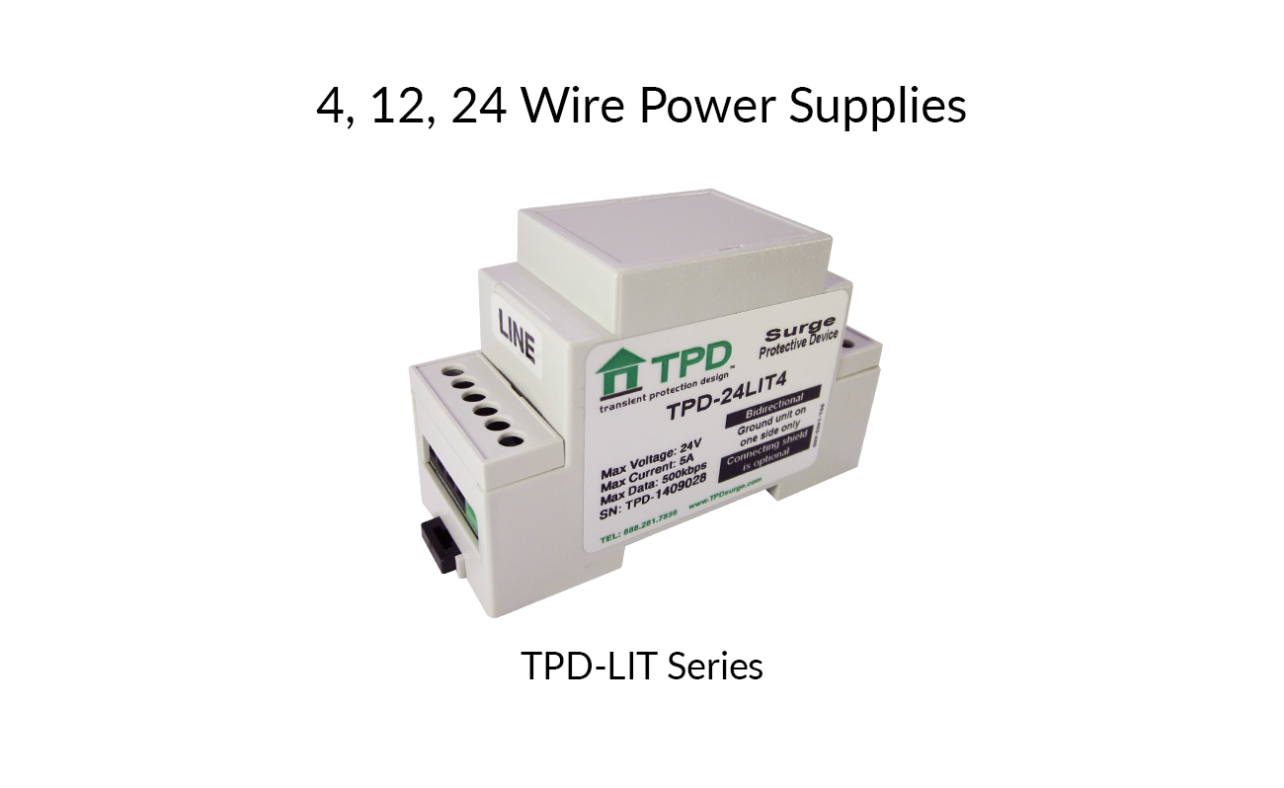Outdoor Camera and WAP Surge Protection
Surge protecting outdoor IP cameras, wireless access points (WAPs), and their pathways back to your building's network is paramount in ensuring uninterrupted surveillance and protection for your valuable assets. Any equipment installed outdoors serves as a potential entry point for lightning strikes into your system, making pathway protection a top priority. With TPD surge protection solutions, you can rest assured that damaging surges and lightning strikes won't infiltrate your network and wreak havoc throughout your systems.
TPD-CAT6-POE IP Camera, WAP
TPD-CAM-BNC BNC Connections, NVR
TPD-24LIT4 4 Wire Power Supply
TPD-24LIT12 12 Wire Power Supply
TPD-24LIT24 24 Wire Power Supply
TPD eliminates transients & surges
which account for 85% to 95% of all
power issues, being the most common
and significantly the most damaging.
How to Surge Protect IP Cameras, NVRs, WAPs and Pathways Back into the Building
Surge Protect POE Cameras: TPD-CAT6-POE
Surge Protect BNC Cameras: TPD-CAM-BNC
Surge Protect WAPs: TPD-CAT6-POE
Surge Protect Power Supplies: TPD-24LIT4, TPD-24LIT12, TPD-24LIT24
Install a surge protector at the network end to protect the network from outdoor IP cameras or WAPs. For high exposure or places of public safety where surge protection is recommended at the camera or WAP, we recommend grounding the unit at the head end and not remotely. Adding additional ground points to any low voltage system can have negative effects and introduced ground potentials.
The Importance of Outdoor Camera and WAP Surge Protection
Preserve Data Integrity
Security camera data pathways are the backbone of surveillance, capturing critical video footage for monitoring and analysis. TPD surge protection shields against electrical damage, ensuring the integrity of surveillance data. Whether it's safeguarding your home or a commercial property, surge protection preserves the clarity and reliability of recorded footage.
Protect Valuable Equipment
Surveillance systems consist of valuable components, including cameras, recorders, and data storage devices. Surge-induced damage can lead to costly repairs or replacements of these components. TPD surge protection serves as a guardian, reducing the risk of electrical damage and extending the lifespan of your surveillance equipment in both residential and commercial applications.
Continuous Security Monitoring
In both residential and commercial environments, a disruption in security camera data pathways can leave properties vulnerable to security breaches. Residential users rely on surveillance for home safety, while businesses depend on it for asset protection and personnel security. TPD surge protection improves the reliability of security monitoring, fortifying security measures in both contexts.
Cost Savings
Repairing or replacing surveillance equipment can be financially burdensome. TPD surge protection acts as a financial barrier against electrical damage, mitigating the risk of unexpected repair expenses. Whether it's safeguarding your home or securing a commercial property, TPD surge protection contributes to cost savings.
Operational Continuity
In commercial settings, security camera systems are integral to various operations, including access control, incident management, and compliance. Surge-induced failures can disrupt business activities, impacting productivity and security. Security camera data pathway surge protection plays a pivotal role in maintaining operational continuity, ensuring seamless security monitoring for both businesses and clients.
Compliance and Evidence Reliability
Compliance with industry standards and ensuring the reliability of surveillance evidence is paramount in both residential and commercial security setups. TPD surge protection helps meet these requirements, ensuring that surveillance systems perform reliably and adhere to industry standards. It ensures the credibility and admissibility of surveillance data in legal and compliance scenarios.
TPD surge protection for security camera data pathways is imperative for preserving data integrity, protecting valuable equipment, maintaining uninterrupted security monitoring, achieving cost-efficiency, ensuring operational continuity, and meeting industry standards in both residential and commercial applications. It provides peace of mind, reliability, and data security for homeowners and businesses alike, ensuring that every frame of surveillance data is clear, reliable, and free from disruptions.
How it Works
When lightning hits a structure or strikes the earth nearby, the energy can be induced onto outdoor camera wires that come from inside the building. These copper lines act like an antenna. Once lightning energy gets onto these copper lines, it looks for ground. In most cases, the energy will travel through NVRs and network switches to find the power ground.
Another way lightning can damage camera systems is by creating ground currents (or ground loops) in the system. When outdoor cameras are powered remotely, or powered by a different breaker panel than powers the DVR or network, a nearby lightning strike can produce damaging ground currents within the system. Parking lots, public garages, storage facilities, and large custom homes with multiple buildings suffer some of the most severe damage from nearby lightning strikes. This is the result of different ground potentials within the system. See our page on Ground Loop Surge Filters for more information on how to protect your business’ or home’s DVRs and network from damaging ground loops and surges.

